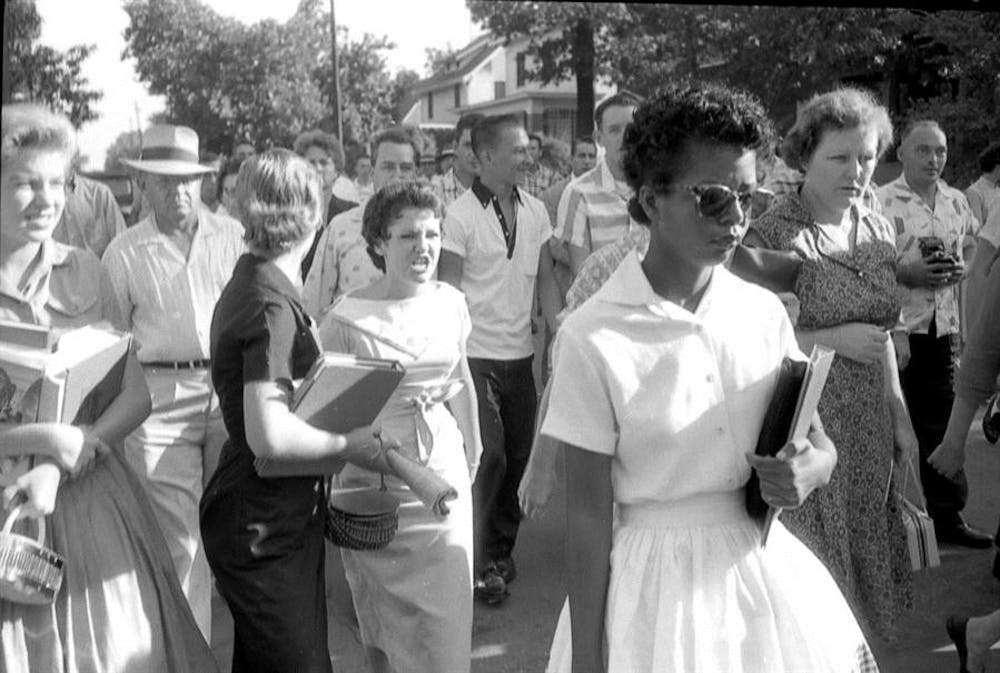The moment captured by the lens of Ira Wilmer (Will) Counts Jr. of 15-year-old Elizabeth Ann Eckford and Hazel Bryan Massery spoke for itself.
Eckford, an African-American student, cast her shaded eyes downward and was determined to not let her tormentor see her cry.
It was Sep. 4, 1957, and Eckford was one of nine African-American youths denied access to Little Rock Central High School in Little Rock, Ark., by a National Guard blockade deployed by segregationist Governor Orval Faubus.
The “Little Rock Nine” had been selected by the National Association for the Advancement of Colored People, in conjunction with the 1954 Brown v. Board Education decision that called for the integration of American public schools, to enroll in the previously all-white Central High, making them the first group of black students in history to do so.
“When we get together and have a book signing, she would always cover that page of the book (with the famous photo),” said Counts’ widow, Vivian, of Eckford, who suffers from post-traumatic stress disorder. “She just could not even look at it again. It did a number on her. She was afraid that they were going to kill her. It really influenced her entire life.”
On Sep. 22, 1997, the Countses succeeded in reconciling Eckford and Massery in Little Rock, hometown to all four individuals and where Eckford still
resided.
“You’re mighty brave to want to go through this,” Eckford had said to Massery in the doorway of her childhood home, less than a mile away from Central High.
That day, both women stood in front of their alma mater, and Counts took another picture.
This time, both women had relaxed smiles on their faces, one arm wrapped around the other.But Eckford was already preparing for the storm of media coverage she knew would descend upon both their lives as soon as the photo was published.
In 1999, then-Vanity Fair reporter David Margolick, in Little Rock on another assignment, chanced upon the 1997 picture in Central High’s visitor center.
“I just thought that it was amazing that these two people who represented racial antagonism had come together,” Margolick said.
After seeing the photo, he was inspired to write “Elizabeth and Hazel: Two Women of Little Rock,” a book that recounts the taking of the original photo and its impact on the two women’s lives, as well as the world.
Margolick will discuss his book today at 7 p.m. in the Whittenberger Auditorium at the Indiana Memorial Union. His talk opens the School of Journalism’s Spring 2012 Speaker Series and is free and open to the public.
The now-Vanity Fair contributing editor published his first documentation of the story behind Counts’ 1957 photo, titled “Through a Lens, Darkly,” on Vanity Fair’s website in 2007.
But Margolick said he faced a huge obstacle in the writing process — Massery had refused to speak to him for eight years.
“Hazel thought that I wasn’t going to be fair to her, and she wanted this story really to go away,” Margolick said. “Hazel felt very skeptical of me, as she thought that I would take Elizabeth’s side.”
But once she saw the article in 2007, Massery said she saw Margolick was even-handed and could be trusted. She began to work with him for the next
four years.
The book, according to Margolick, is much more comprehensive and balanced than the article. Both women’s sides of the story are told, and more historical background is given, such as information about the lives of Counts and jazz legend Louis Armstrong.
Two years after their reconciliation, Massery and Eckford had become good friends. They were traveling around the country, sharing their experiences and teaching others about the importance of racial tolerance, according to Counts.
By 2001, the friendship between Eckford and Massery had fallen apart. The women have not spoken to each other for the past 10 years, according to Margolick.
“Two people like these simply can’t just shake hands and pretend that all this history hasn’t happened,” Margolick said about the tension that started to develop between both women due to a string of misunderstandings and differing expectations.
“And it’s a very sad thing because you can see that the two of them still feel very bonded together,” he said. “There’s still a very profound tie between the two of them. But they’re both very proud and stubborn people, so they remained in a kind of impasse.”
While Eckford remains in the public eye and is still willing to speak to the press, Massery has refused all interviews after her last one with Margolick.
Margolick said Massery felt bitter about the whole experience of coming forward and apologizing to Eckford.
“In a peculiar sort of way, Elizabeth has overcome it better than Hazel has,” Margolick said. “It’s one of the great paradoxes in the story, that Elizabeth has moved on with her life and has really emerged from the shadows, whereas Hazel has receded back into the shadows.”
Margolick described how he tried to analyze the quality, composition and symbolism of Counts’ photo.
“I stared at that picture for hours repeatedly,” Margolick said. “And every time I looked at it I would discover something new about it,” he said.
Author, editor reflects on ‘Elizabeth and Hazel’

Get stories like this in your inbox
Subscribe





